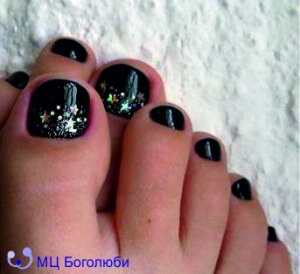Fungal infections of the nails, also known by the term «onychomycosis» - are a very common type of nail plate disease. In fact, among all diseases associated with nails, mycoses account for 50%.
Mycetes (fungi, mold or yeast) trigger an infection that can remain "closed" on one finger or affect several.
A fungal disease usually begins with a change in the color of the nail itself. If mycosis is not diagnosed in time, this can lead to various complications. For this reason, as soon as you notice chromatic changes in the nail, we recommend to contact a dermatologist at the «Bogoliuby » MC. The longer the patient lets the situation take its own course, the greater the risk to health.
Mycoses, as already mentioned, are very common diseases that affect patients of any ethnic group, more often men than women.
Onychomycosis is often determined by dermatophytes, that is, fungi, which under normal conditions live on the skin and nails of a person, without creating any problems. But in certain situations, for example, in the event of a decline in the patient’s immune defense, these dermatophytes begin to replicate unhindered.
Fungi multiply intensively in warm and humid places. The feet are more active than the hands, are exposed to heat and moisture when wearing shoes and socks, so onychomycosis often affects the toenails.
Risk factors
The main "culprits" of the disease are the microorganisms related to the genus: Candida, Trichophyton, Epidermophyton and Aspergillus. These mycetes flourish in public locker rooms, pools and showers. Visiting such places barefoot is one of the main risk factors for the development of onychomycosis.
Other risk factors, both physiological and pathological, are:
- diabetes;
- elderly age;
- psoriasis;
- wearing tight shoes;
- excessive sweating;
- drop in immune status.
Symptoms
The main sign of the disease – is that the nail changes color: from white to yellow. Stains may appear - brown, green or black. If a fungal infection has penetrated deeply, then the nail becomes thicker and collapses. The surface of the nail looks more fragile, loose and deformed.
Progressive mycosis can cause a bad smell or even cause loss of nails. In serious cases, the disease spreads to the skin of the legs and hands.
How to treat nail fungus
Onychomycosis is not easy to eradicate. Usually, the doctor prescribes local (enamels and ointments) and systemic (oral) antifungal drugs. These drugs affect the fungus, destroy it and contribute to the development of a new uninfected nail.
Unfortunately, the pharmacological treatment of mycosis is very long, since it takes from 9 months to a year for a completely new nail to grow. Only in very serious cases can a specialist recommend surgical removal of the nail.

















